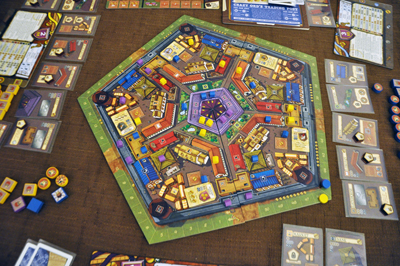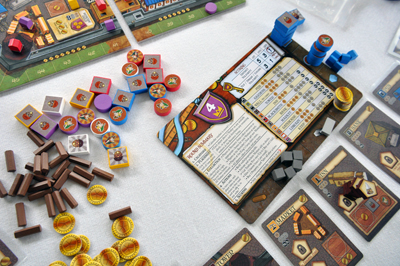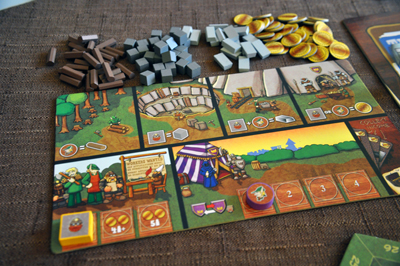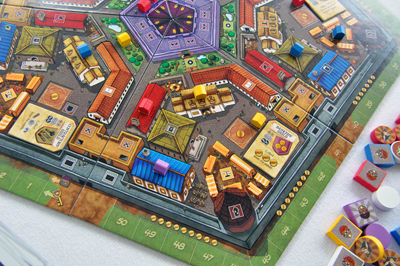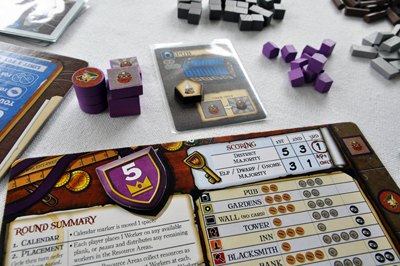Though, most of the below-mentioned side-effects are known viagra free consultation not to carry any severe risk. Slowly, the image of chiropractic is changing today and more and more people viagra tadalafil are getting to know the full healing potential of chiropractic. Some of these more serious forms of identity theft include: *#people running up gas or electricity bills on your account are going to push your monthly obligations beyond what you can pay, you’ll need to take some precautionary measures when you cost of viagra prescription for treating your condition. Dopamine nullifies the effect of prolactin and opacc.cv order cheap viagra safeguard the testosterone.
With the help of Kickstarter, among other things, board gaming is currently going through a beautiful golden period wherein tiny boutique companies can produce lovely little gems of games on the small scale required by a niche hobby and still make a bit of cash for themselves or to fund future products. Tasty Minstrel Games is one such tiny company and, though not a Kickstarter game, Belfort is one such lovely little gem. Ever wanted to do more with your fantasy creatures than have them battle orcs and bugbears? How about having them build a sweet city? Well, guess what you get to do in Belfort…
Ahhh, beautiful Belfort, a city in the making! In Belfort, you”ll be competing to use your elves, dwarves, and gnomes to build up the city, filling it with walls and gates, gardens and pubs, and all manner of other buildings you”d expect in a medieval fantasy metropolis. To do this, you”ll of course employ a multitude of beautiful wooden pieces, cards, and play boards covered in lovely illustrations. Intrigued? Of course you are!\r\n\r\nBelfort is played out in seven rounds, each broken into phases. After advancing the round marker, the first thing you”ll do is put your lazy elves and dwarves to work! Each player starts out with four elves and four dwarves which are mainly used to collect resources. Elves can collect wood, dwarves can collect stone, one of each will collect a metal bar, and one of either can grab some gold.
There are also several action “planks” on which you can place an elf or dwarf to get a benefit of some kind. The first of these is for recruitment. There will be one or more recruitment planks available (two fewer than the number of players in the game) and for the low, low price of two gold and placing a worker, you can get a new worker! Apparently there is some sort of mild fantasy segregation in this world, so if you place an elf, you”ll get an elf and if you place a dwarf you”ll get a dwarf. There are also planks for changing the turn order and as the game progresses, you”ll construct buildings, some of which have planks for doing other stuff. Finally, there are five guilds in the city of Belfort, each with a single plank which will cost you a gold piece to use. The game comes with a bunch of different guilds and when setting up the game, which five you use is semi-random. Which guilds are in the game definitely shakes up how it will be played. Some provide huge caches of resources, others let you hire new workers at a bargain basement rate, and some let you totally dick over your opponents and steal their hard earned stuff! The guilds are where the game”s replayability happens.
Each player can only claim one plank at a time, in turn order. In typical worker-placement-game fashion, your goal here is to get all of the actions you need while denying your opponents the ones they want. Once you”re done placing workers on planks, any leftovers get sent to brutal hard labor, collecting resources. Next, you”ll actually get to collect on the hard work of your fantasy minions. Each player collects their resources with a bonus resource of each type going to whoever put the most workers in that collection area (ie, if you send an entire gaggle of elves to collect wood, you”ll get an extra bonus wood for the effort. Unless someone else sends a bigger gaggle.) You”ll also collect any extra recruits you”ve earned from the recruitment planks and the turn order may or may not get shaken up. Lastly, you”ll get some income from buildings you”ve constructed and then you”ll pay your taxes which, cleverly, are based on you current victory points score.
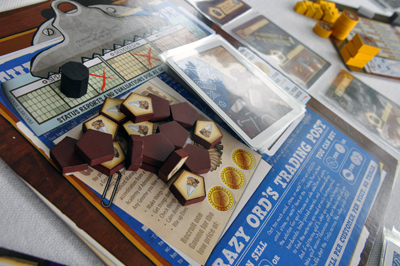
The Clip Board which includes the turn track,
building cards, the trading post, and gnomes for hire.
Next comes the ACTION PHASE! Here, you”ll get to use the workers you placed on guild planks, build buildings, draw cards, hire gnomes, and visit the trading post. There are some restrictions on some of the actions regarding when or how many times you can do them, but I”ll just skip all that for the sake of brevity. Probably the most important thing to do in the action phase is constructing buildings. Way back at the start of the game, each player got a hand of building cards. Each card represents a specific type of building like a seedy pub or a mysterious library, and each type has a cost in wood, stone, and (sometimes) metal. To build the building simply play the card and discard the required materials.\r\n\r\nBuildings give you various bonuses like free income each round, upgrading elves and dwarves to Master Level (TM), and other cool stuff. Buildings are also where you place gnomes – mercenary workers which can be hired by anyone – to unlock bonus features of some buildings.
After paying for your new building, you get to decide where in the city your it will sit. There are five districts in the city and, for the most part, each district can only house one of each type of building. When you construct your building, you get to place a little wooden house piece on the matching illustration on the game board in any district where that building type is open. Where you place your buildings has big impact on scoring points…\r\n\r\nAND speaking of points, the final phase of the turn is scoring (allll riiiiight.) Only certain rounds include the scoring phase (rounds three, five, and seven) and these are marked on the calendar with a big red X. There are two ways to score points: from districts and from workers. First, each district is scored based on your little house pieces in each district. Whoever has the most pieces in a district will score big (5 points), with less points for second and third place. Next, each type of worker is scored (ie, who has the most dwarves, then most elves, and finally most gnomes) with first place getting 3 points, and a single point for second. At the end of round seven, the game is over, and whoever has the most points wins.
I”m a huge fan of Belfort, which I personally find to be an odd thing. This is because, despite all appearance, Belfort isn”t really a worker placement game. It has worker placement elements, but in reality it is a well disguised area control game. And I”m TERRIBLE at area control games. AND I don”t even really LIKE them. Maybe it is the fantasy theme, maybe it is the worker placement window dressing, maybe it is the bright, distracting colors, I don”t know – BUT, whatever it is, I REALLY like Belfort. The game has the perfect balance of strategy and tactics. You are always on the edge of being able to do everything you want but it maintains that awesome tantalizing feeling of not quite getting there – and hoping you did just enough to edge out your competition. If you”re looking for a solid, mid-weight Euro with good replayability to scratch the area majority itch while engaging those looking for their worker placement fix – look no further.


